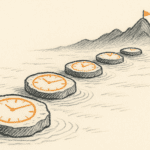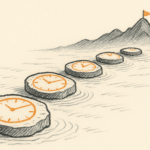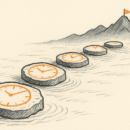Planning for tomorrow is not about forecasting
“…three financial economists — Itzhak Ben-David of Ohio State University and John R. Graham and Campbell R. Harvey of Duke — found that chief financial officers of major American corporations are not very good at forecasting the future. The authors’ investigation used a quarterly survey of C.F.O.’s that Duke has been running since 2001. Among other things, the C.F.O.’s were asked about their expectations for the return of the Standard & Poor’s 500-stock index for the next year — both their best guess and their 80 percent confidence limit.
…It turns out that C.F.O.’s, as a group, display terrible calibration. The actual market return over the next year fell between their 80 percent confidence limits only a third of the time, so these executives weren’t particularly good at forecasting the stock market. In fact, their predictions were negatively correlated with actual returns.”
RICHARD H. THALER, The New York Times (21 August 2010)
In business, we periodically sit down to forecast the future. In ordinary life, such a pursuit is left to crystal-ball gazers, astrologers, medicine-men and assorted charlatans. But in the corporate world it seems to acquire the veneer of respectability. When accompanied by spreadsheets and charts, prediction becomes believable.
Except it isn’t. As economist Richard Thaler wrote in his recent NYT piece, we are actually all terrible at forecasting – even those of us who think we are good at it. This is a problem that is particularly acute at the top of organizations. Thaler referred to a study of chief financial officers which found that they really couldn’t predict stock-market returns a year ahead, even within a confidence limit. Yet these officers build seemingly rigorous predictions about interest rates, exchange rates, input prices and the like into their spreadsheets all the time.
CEOs are no better. They routinely make predictions about future performance that are wide of the mark. They get into dubious acquisitions on nothing stronger than their own hubris, and shareholders often pay the price. After a short run of success, CEOs think they will keep increasing their market share at the same rates, never factoring in what competitors might do in response.
The problem here is not that senior bods can’t forecast well. No one can, not even the people trained and paid to do so. The problem with senior executives, as Thaler put it, “…is that as a group, many of these executives apparently don’t realize that they lack forecasting ability.” In other words, it’s not what you don’t know that gets you into trouble; it’s what you don’t know that you don’t know!
We should really be way more thoughtful when it comes to matters of the future. As senior executives, we must have a handle on tomorrow – having a vision of the future and a sense of direction are essential functions of leadership. People follow us because they think we know where we are going. But be careful: you usually don’t know the future any better than your followers do. What you can do, however, is prepare for a possible range of futures, so that your organization is ready for pretty much anything that comes at it.
Good chief executives do this routinely: get their people to construct possible future scenarios, good and bad. This is very different from predicting or forecasting what lies ahead. You do not really take a view on which scenario will turn out to be true. What is important is to imagine a range of future worlds, and to imagine what your organization might do in such worlds. How will it compete? What will be different, and what will remain the same? The key thing is to understand the set of things that you have to do today to prepare for a range of tomorrows.
And so, to plan for tomorrow: imagine, don’t forecast.

Buy Sunny Bindra's new book
The X in CX
here »
Popular Posts
- Where are you rushing to—your funeral?June 29, 2025
- The map will appear—once you start walking.July 6, 2025
- We’re letting the bad drive out the goodJuly 20, 2025
- The grace of the giverJuly 27, 2025















